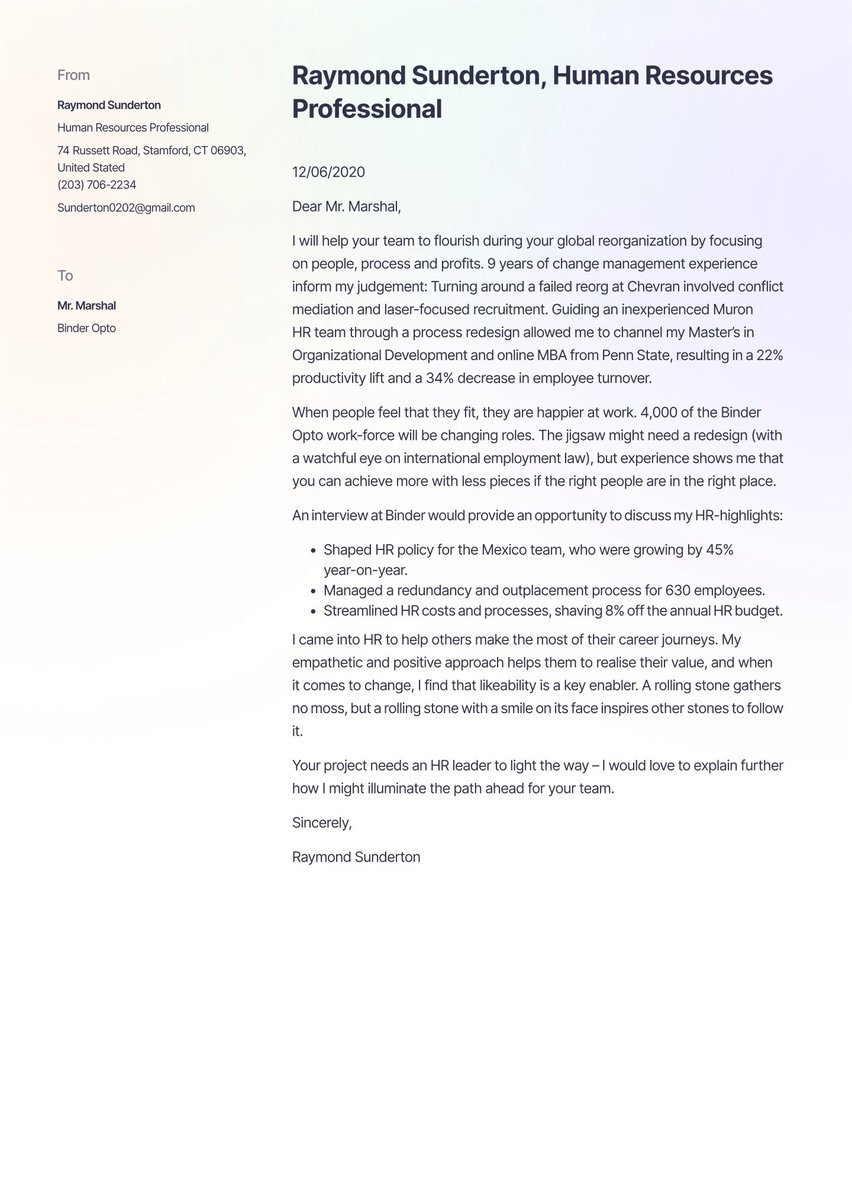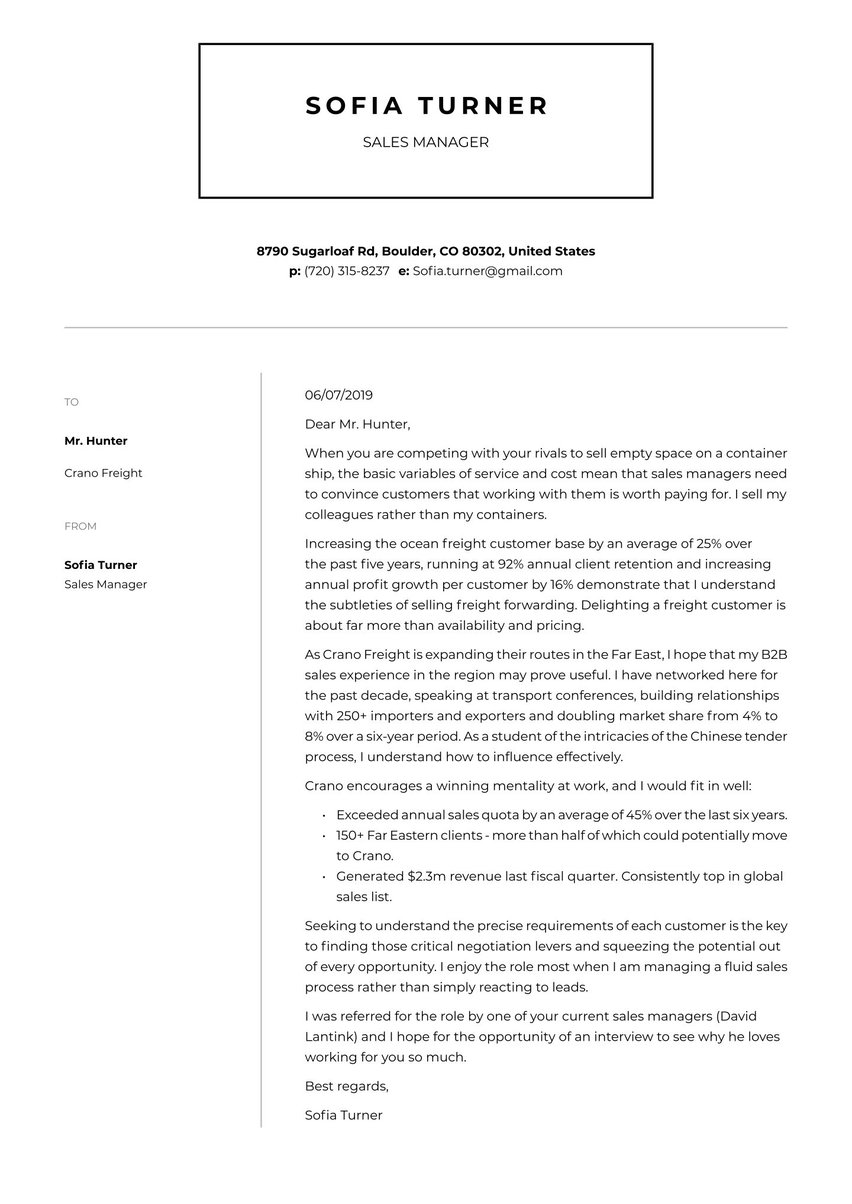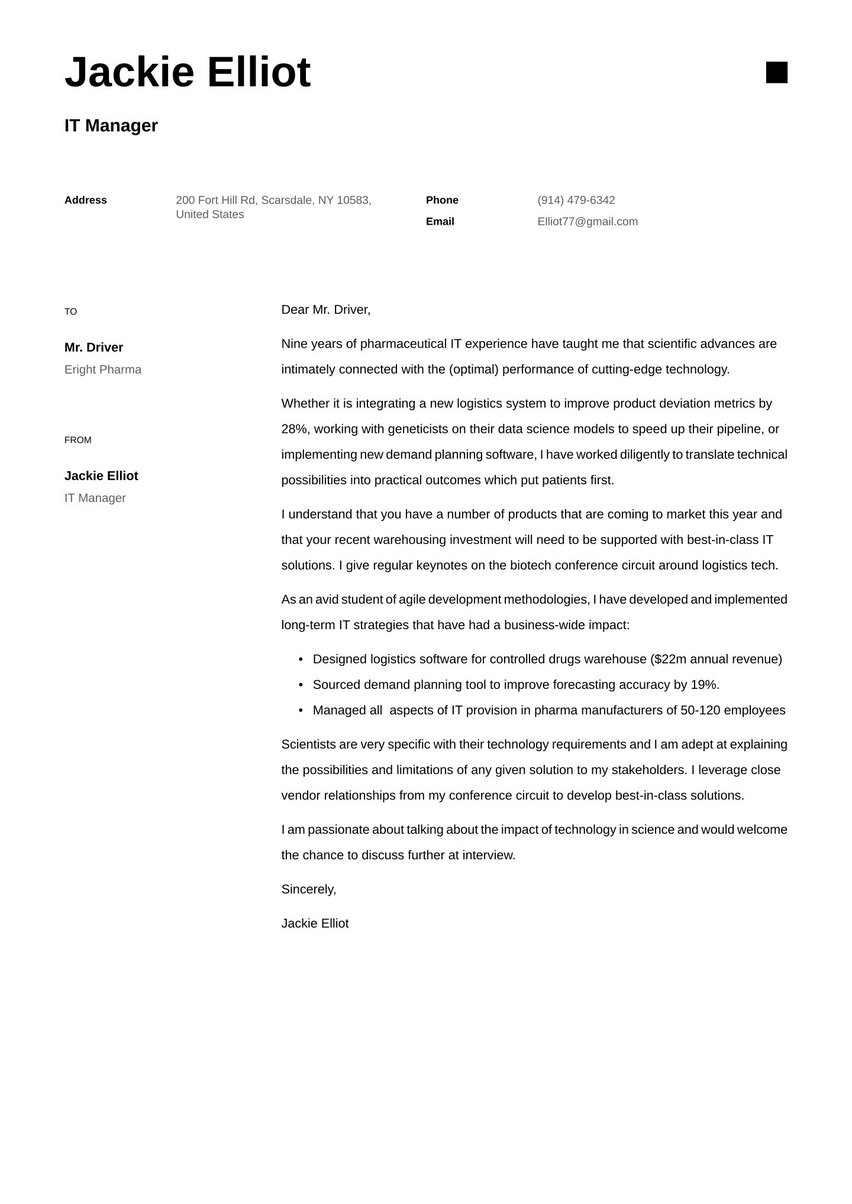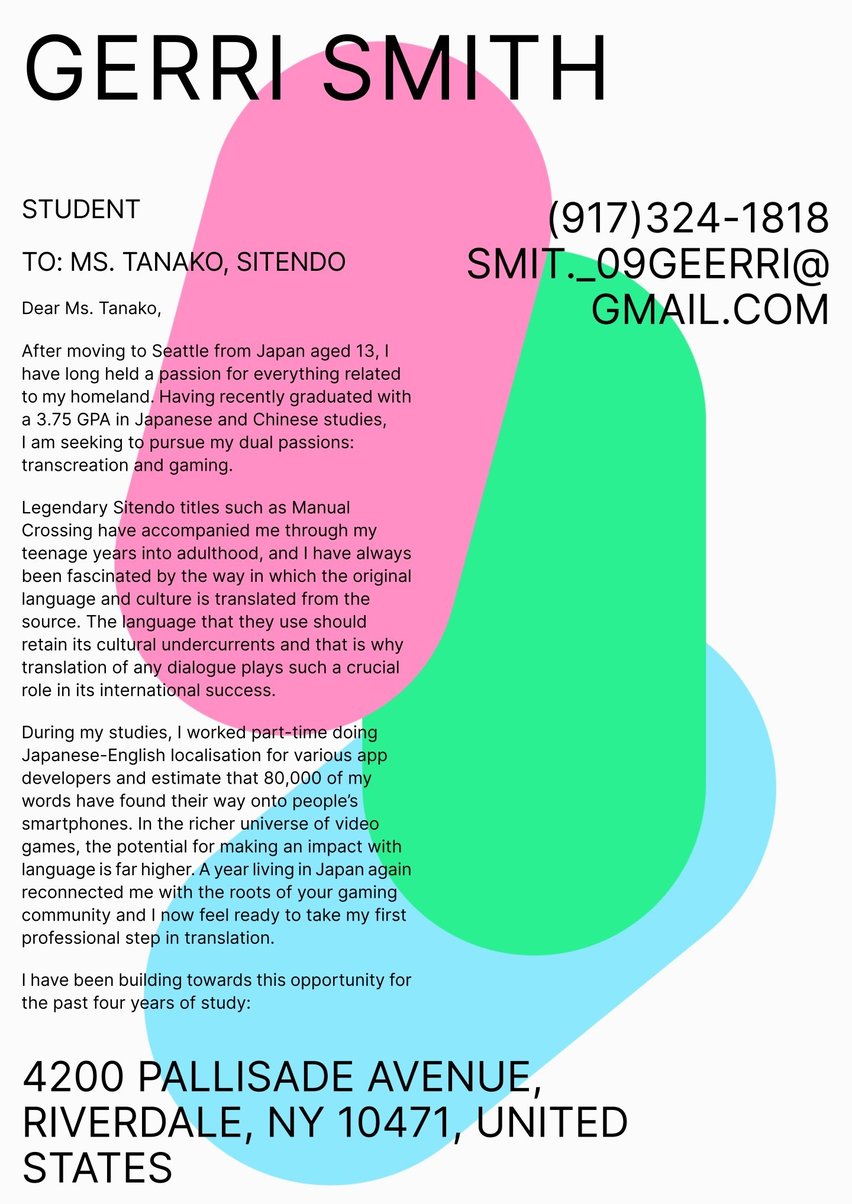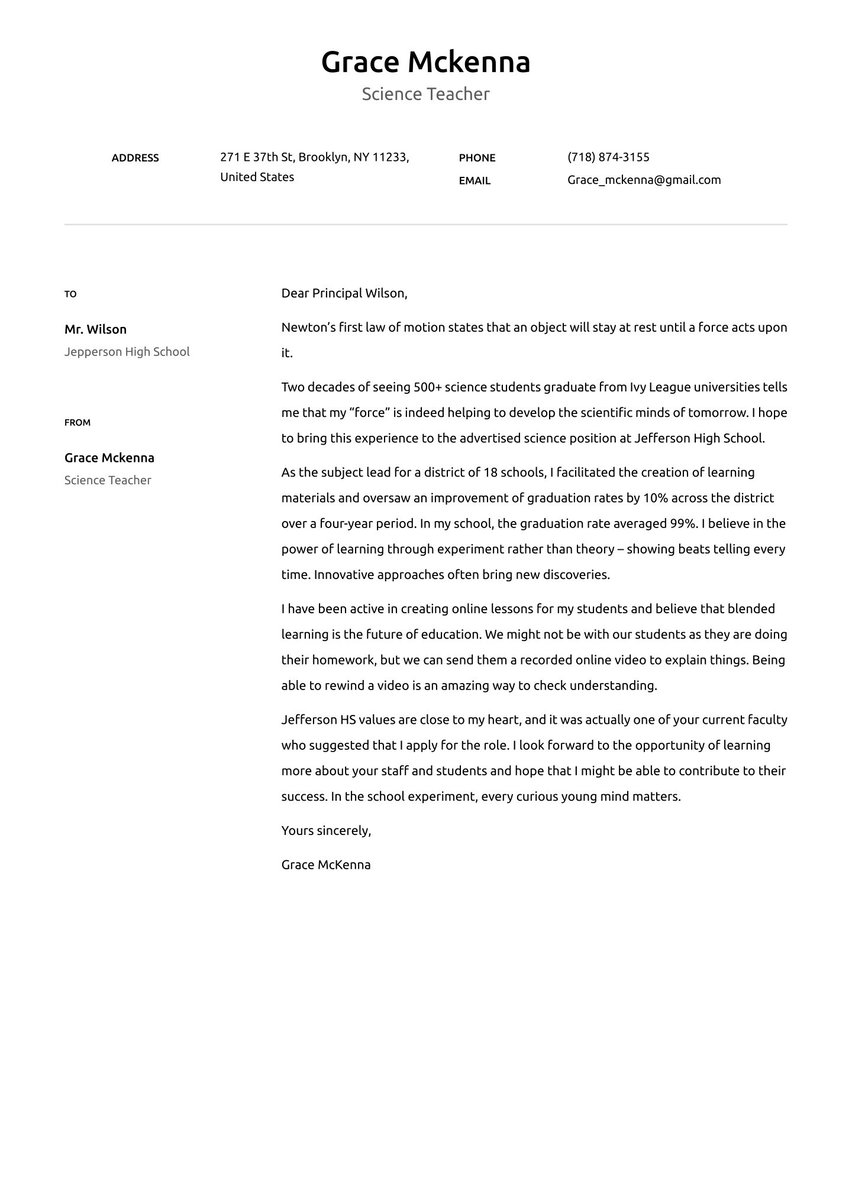So it’s time to tackle what might just be your very first cover letter, eh? You might have been under the impression that resumes and cover letters were only for getting jobs in the adult world. As it turns out, students need cover letters for a variety of reasons as well. Whether it’s for a program, leadership position, internship, scholarship or your first job, a great cover letter can help you stand out from the competition and tell your story in a passionate and convincing way. In both high school and college, competition among talented students can be fierce. And test scores and report cards can only tell so much. A great cover letter can be your secret weapon to excel past students who have perfect grades but lack the charisma and character that differentiates one candidate from another.
A highly-polished cover letter is usually only one part of a complete application. If you haven’t created an exceptional resume yet, that’s a great place to start. Check out resume.io’s guides specifically for high school and college students. You can also browse our resume examples for hundreds of professions – great for in-depth information when applying to jobs and internships. Our templates and general resume writing guide can help you make sure your formatting and visual presentation is spot-on. Now it’s time to dive into the inner workings of a cover letter that portrays your passion, motivation and eagerness to learn. You may not have a lot of professional experience, but that doesn’t mean your cover letter can’t shine with all the qualities that make you unique. This guide, along with an effective cover-letter example will:
- Review the basics of cover letter writing and why this document is so important
- Break down cover letter writing into easy-to-follow steps
- Explore one of the biggest mistakes made by students on their first cover letters
- Help you stand out from the competition no matter the type of application.
Student cover letter sample and general info
The purpose of a student cover letter
A cover letter can sometimes be called a letter of motivation, application letter or letter of interest. Whatever form it takes, the objective is simple: introduce you, your goals and your experiences to a potential employer, scholarship committee or any other type of decision-maker. Whereas a resume’s potential for creativity is limited to just a few lines of profile summary, a cover letter offers much more room for freedom of expression. A resume’s format is geared towards dates and job titles, which can be daunting for students who are just entering the professional sphere. A cover letter allows you to focus on just one or two positions or even your top personality traits and expand on the skills you already have to convince the reader that you’re worth a shot.
Hard vs. soft skills
A student may have not yet accumulated all the hard skills needed to succeed in his or her industry, but these types of concrete abilities aren’t the only ones that count. A study of recent business graduates conducted across four European countries found that students need more professional development when it comes to soft skills. Employers were impressed with the business students’ analytical abilities but found them lacking when it came to communication and presentation.
So what does that mean for your cover letter? Even if you haven’t amassed much technical knowledge, showing off your professionalism, drive and ability to make a personal connection can go a long way – no matter which industry you work in.
As a student, you should keep your cover letter between 200-400 words, or the length of one page including your heading and closing items (more on that soon). Students often try to make up for lack of experience by creating long, rambling cover letters that address every topic imaginable. In fact, a concise and pointed letter that focuses on just a handful of great qualities is much more effective. Styling is also an important part of a strong cover letter. In general, it’s best to stick to an 11-point font size in one of the more common sans serif fonts like Georgia, Helvetica, Arial, Calibri or Open Sans. For more information on precise formatting, check out this overall guide on cover letters.
Making your own opportunity
Whether from parents, peers or teachers, students face a lot of pressure to excel and win opportunities. Sometimes it can feel impossible to compete. The great thing about a cover letter is that it helps to level the playing field. Anyone can learn the secrets to writing an effective letter that gives them a leg up on the competition – yes, even when your opponent is that one kid who hasn’t missed a day of school since the 2nd grade.
You may face a situation where the position or scholarship you’re applying for doesn’t specify whether or not you need a cover letter. This is your moment to get it right where a lot of other candidates may not. Unless an application specifically asks you NOT to submit a cover letter, you should always write and send one even if it’s not mentioned in the materials list. A cover letter is an opportunity to convince an employer or committee that you’re reliable, hard-working and destined for success. Why would you throw that opportunity away? Each material you prepare increases your odds of getting the thing your after, so make sure to give your cover letter all you’ve got.
The importance of tailoring your cover letter
If you’re writing your first cover letter in advance just to be prepared – way to be proactive! When it comes time to submit it, though, you’ll want to be sure you make a few changes. Each cover letter should serve a unique purpose that aligns with the mission of the company or organization that will be reading it. Hiring managers and scholarship committees can tell if you’ve created a generic letter – or worse, copy and pasted one – and topped it off with their name. This type of letter shows that you didn’t take the time to research the company and didn’t care to put in the effort to meet their needs.
Luckily, you can easily avoid this mistake with a little planning. Read the job description or call for applicants a few times to pick out the most important attributes the organization is looking for in their candidates. Use your cover letter to highlight your successes in these areas or expand on coursework and relevant experience that match the specific job and type of employee the company is looking for. That’s the best way to maximize your chances.

Best format for a student cover letter
As a student, you’ll probably be using your cover letter for a variety of purposes – after tailoring it to each one, of course! Luckily, a professional cover letter structure is much the same regardless of industry or job position. This framework also works for scholarships, programs and any other type of application you may need to complete. Here are the key components:
- The cover letter header
- The greeting
- The introduction
- The letter body
- The conclusion
- The signature.
The student cover letter sample below can be used for inspiration or adapted for your own needs.
Dear Ms. Tanako,
I moved to Seattle from Japan at age 13 and have long held a passion for everything related to my homeland. Having recently graduated with a 3.75 GPA in Japanese and Chinese studies, I am seeking to pursue my dual passions: transcreation and gaming.
Legendary Sitendo titles such as Manual Crossing have accompanied me through my teenage years into adulthood, and I have always been fascinated by the way in which the original language and culture is translated from the source. The language that they use should retain its cultural undercurrents and that is why translation of any dialogue plays such a crucial role in its international success.
During my studies, I worked part-time doing Japanese-English localization for various app developers and estimate that 80,000 of my words have found their way onto people’s smartphones. In the richer universe of video games, the potential for making an impact with language is far higher. A year living in Japan again reconnected me with the roots of your gaming community and I now feel ready to take my first professional step in translation.
I have been building towards this opportunity for the past four years of study:
- 18-months (remote) work experience with Japanese app developer Luevho.
- Lived in Guangdong for six months – strong additional Mandarin and Cantonese.
- Translated five 60,000-word fiction books from Japanese into English.
- Localized comics from English to Japanese. I am a student of Tokyo pop culture.
On a technical note, my thesis was written around the future of artificial intelligence in our industry. Finding a balance between art and science has never been more important.
I am a conscientious, energetic and creative member of any team and hope to have the opportunity of understanding how I might find become your newest translation “villager.”
Sincerely,
Herman Walton
Cover letter header
Once upon a time, people sent applications (and cover letters) in the mail. Now, the majority of your applications will be online. A cover letter heading once meant formal letter heading, which you should still use on the off chance you have to send something the old-fashioned way. Otherwise, a cover letter heading serves one primary purpose: identify the document as belonging to you. Beyond that, it also keeps your phone number, email, LinkedIn and other contact information at a recruiter’s fingertips in case the letter floats around a large office. It’s a smart idea to keep your header concise to leave you more room for convincing an employer that you’re the one.
The goal of this section: Make sure everyone who comes in contact with your letter knows who it belongs to and has your information to get in touch.
Your cover letter header also plays a role in the formatting of your letter. Here is the one place where you may be able to add a splash of color or a stronger text element depending on the industry and organization you’re applying to. One thing you can do to appear even more polished is to align your document styles. That means using the same header across your student resume, cover letter and any other application materials. A template can make things much easier by helping you find the right balance of professionalism and creativity.
Cover letter greeting
Your greeting is one of the shortest sections of your cover letter but it serves a big purpose in making sure you make a great first impression. Your greeting sets the tone for the rest of the letter and should convey respect and professionalism. In most cases, there’s no need to go overboard with the formality, though. “Dear” followed by the proper salutation and a last name can work well in a variety of situations.
The goal of this section: Create a polite opening that properly and professionally addresses the reader.
It’s been scientifically proven that people love to hear their own names. You can use this golden tidbit to your advantage by making sure to address your cover letter to the person who will be reading it. In many cases, employers and organizations who work with students will leave the contact person’s name on the call for applications. Sometimes, this can also serve as a test to see which students are paying enough attention to incorporate it into their letter.
In the instance where any number of people in a large organization could be reading your letter, there’s no need to go to extreme lengths to find a specific name. In that case, it’s best to avoid the cold and outdated “ To Whom It May Concern.” Instead, try to include the company name in your greeting followed by a collective noun like “Team” or “Committee.”
Dear Ms. Tanako,
Cover letter introduction
The introduction is the hook of your letter. The opening paragraph is your chance to grab the reader’s attention with an interesting anecdote, bold statement or energetic opening line. Companies and organizations often enjoy working with students for their creative approaches and fresh ideas. Don’t put your reader to sleep with a halfhearted opening like “I am writing to inquire about your vacancy for…” Instead, encourage them to keep reading into the body of your letter by offering a taste of your best qualities in the introduction.
The goal of this section: Create a bold and attention-grabbing first paragraph that makes a reader want to continue.
I moved to Seattle from Japan at age 13 and have long held a passion for everything related to my homeland. Having recently graduated with a 3.75 GPA in Japanese and Chinese studies, I am seeking to pursue my dual passions: transcreation and gaming.
Cover letter middle part (body)
Your body paragraphs make up the bulk of your student cover letter. Here is where you can dive deep into your successes, milestones and perspectives. If the body section feels too free-form, you may opt to divide it into two subsections. In the first, you can use the STAR method to explain a Situation, Task, your Action and the positive Result it had. Remember to limit each anecdote to just a few lines in order to keep your reader’s attention throughout the whole document. In the second section, you can dive into your relevant skills, extracurricular activities and work experience. Make sure to relate each of these things to the position at hand to show why you’d be a great fit within the organization.
The goal of this section: Offer details on your unique qualities and previous experiences and give specific examples of your problem-solving and collaborative capabilities.
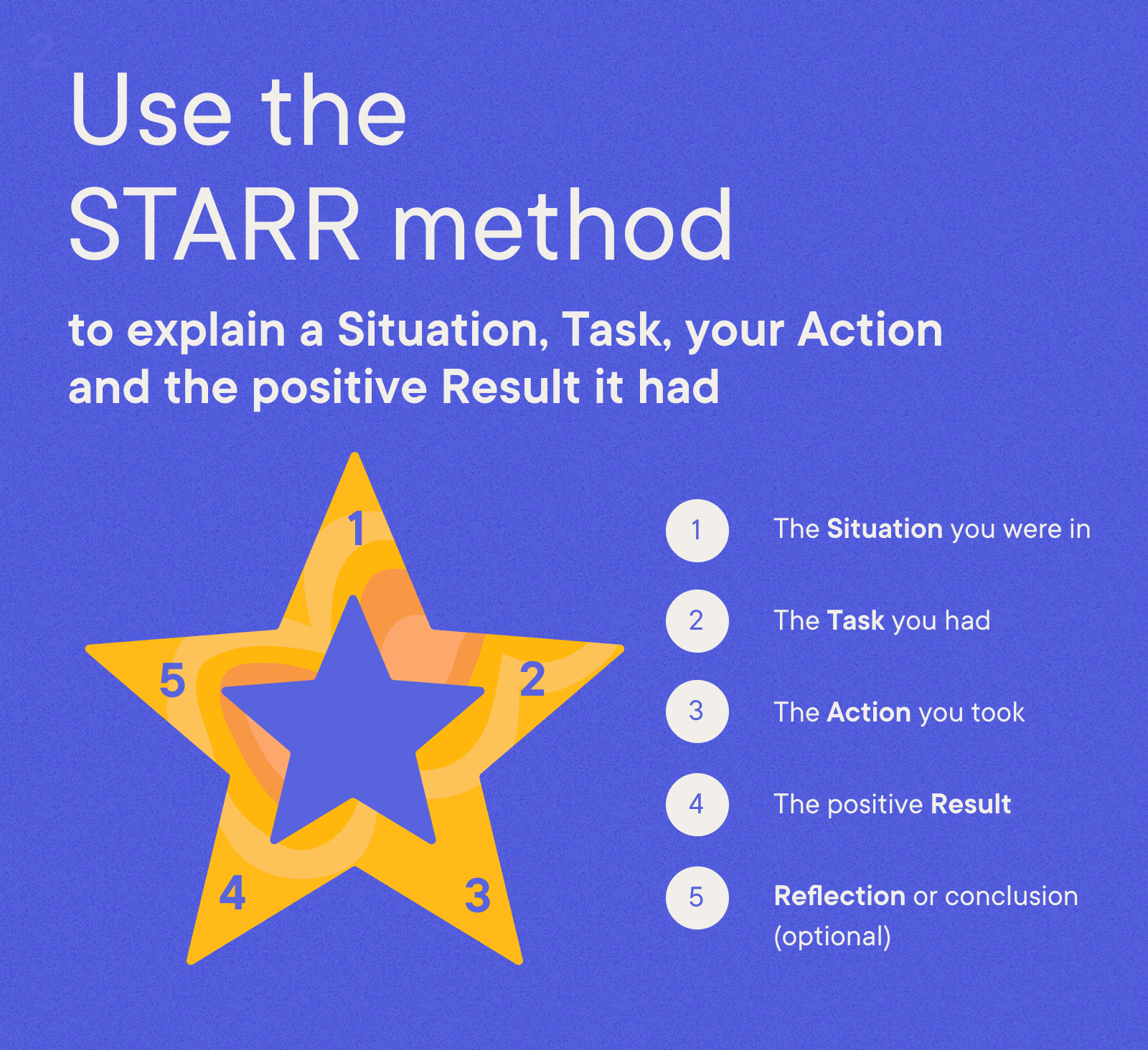
During my studies, I worked part-time doing Japanese-English localization for various app developers and estimate that 80,000 of my words have found their way onto people’s smartphones. In the richer universe of video games, the potential for making an impact with language is far higher. A year living in Japan again reconnected me with the roots of your gaming community and I now feel ready to take my first professional step in translation.
I have been building towards this opportunity for the past four years of study:
- 18-months (remote) work experience with Japanese app developer Luevho.
- Lived in Guangdong for six months – strong additional Mandarin and Cantonese.
- Translated five 60,000-word fiction books from Japanese into English.
- Localized comics from English to Japanese. I am a student of Tokyo pop culture.
How to close a student cover letter (conclusion and sign-off)
Congratulations on making it to the conclusion of your cover letter! All you’ve got to do now is write a closing paragraph that’s polite and encourages the reader to get in touch to learn more about what a fabulous candidate you are. The best way to do this is via a Call to Action. This line shows that you’re eager to take the conversation further and invites the reader to contact you. You’ll want to sound confident and determined without coming across as cocky or presumptive. Then, sign off your letter with a standard greeting like “Sincerely,” “Best,” or “Best regards.”
The goal of this section: End the letter on a strong and positive note and create an effective call to action that politely and professionally encourages the reader to get in touch.
I am a conscientious, energetic and creative member of any team and hope to have the opportunity of understanding how I might find become your newest translation “villager.”
Sincerely,
Herman Walton
Writing psychology – cover letter tools and strategies
As a student, there are some general qualities that you can convey in your cover letter regardless of the type of application: Professionalism and maturity: Many students assume that they don’t need to have a *perfect* cover letter given that they are just starting out. While it’s true that your reader may be used to dealing with students, it’s not an excuse to write whatever comes to mind. An HR rep or scholarship committee will be impressed by a student who can show discipline and focus despite their young age.
Motivation: Demonstrating that you have goals and have taken concrete steps to achieve them is one of the best ways to show that you’re a student worth investing in. The STAR method listed in the body section of this guide can help you succinctly explain the ways you take action.
Willingness to learn: No matter how much you think you’ve learned, a student who comes across as arrogant or entitled will be an automatic “no, thank you” in the eyes of many internship coordinators, program leaders and scholarship committees.
Passion: Many of your other positive traits are likely to spring from the passion you have for your subject matter, for school or for the path you are pursuing. Explaining the source of your passion can help you develop a personal connection with your reader.
Bringing value, even as a student
As a student, your focus is on learning, gaining new skills and growing your understanding of a field or industry. All of these goals will help lead you to a successful future. While these ambitions are a natural and normal part of being a student, they often lead to one common cover letter mistake: talking too much about how an opportunity will benefit you. “Of course I’m applying to this job/scholarship/internship/program because it will benefit me!” you might be saying to yourself. That’s true, but so is every other candidate actively preparing their application at this moment. In the professional world – and it holds true for students – companies want to know what you can offer them. Your employment or selection is generally not an act of goodwill on behalf of the company. You will be performing a job or service for them, even as a student.
It may be hard to think of how you can bring value to a company where dozens of other people have years of career experience. While it’s true that your hard skills may not be as fully formed as professional employees, don’t think that you have nothing to offer. Seasoned workers get tired. They lose the motivation to innovate. They don’t embrace new technologies. They’re so focused on getting home at the end of the day that they don’t bring the passion that drives success. You might not have all of the hard skills needed to do their jobs, but your youth is a huge advantage to a company. Without insulting the company or its employees, focus on the ways that you can bring your motivation and passion to this workplace or program. In a respectful tone, convey that you’re a bright young mind with the soft skills needed for that particular job and industry. Instead of coming across like a desperate student begging for a shot, you’ll appear confident and poised to do great things. You’ll be in demand.
The fact is, there’s going to be a lot of other people with your same resume applying for the exact positions that you want. It’s an unfortunate and inevitable part of being a student.
Your cover letter is how you stand out.
Unfortunately, many students incorporate this knowledge into their cover letter by taking a presumptive and over confident tone. Finding the balance between asserting your best qualities and appearing humble can be difficult, but it’s essential to not put off your reader. As a student, you will be working in a junior position. You’re still learning, even if you have great traits that can benefit the company. Just remember – nothing is ever guaranteed until you sign the contract.
Student cover letter common mistakes
Here are some cover letter tips to help you avoid common pitfalls:
- Unrelated information: As a student, there are actually times when your hobbies and interests might be useful information in a cover letter (this is particularly true for high school students). However, if the application is of a professional nature, it’s best to leave off family life, clubs and friends and focus on your connection to the role at hand.
- Formatting and visual style: As a general rule, your formatting should be appropriate for the industry and position you’re applying for. Bright colors and heavy fonts don’t work with more formal employers, so make sure to get the tone just right. A professional template can help.
- Typos and grammatical errors: You’ve got one hour before the application is due and you just want to get it over with! Next time, make sure to leave enough time to proofread and spell checking your document. Better yet, have a friend look over it and give you feedback.
- Generic or overly formal wording: Your cover letter should sound professional but still natural, like you’re a real human being. A reader knows when you’ve copy and pasted someone else’s text or when the words are so large and complicated it’s clear you were just trying to show off. Writing in your own tone of voice is always the better choice.
Key takeaways
- The cover letter is the final “convincer” that lets you influence hiring decision-makers. It’s vitally important and extremely useful EVEN if the internship doesn’t require one.
- Know the cover letter structure and remember the goals of each section.
- Use emotion and psychology to drive home factual points for your internship.
- Convey the right tone of voice and remember what employers are looking for in an intern.
- Avoid generic text, formatting traps from text editors and use visual style (including design elements) to grab attention.
With resume.io, you can create a perfect cover letter in just a few minutes. No uncertainty, no hassle. Go out there and win!
You may also want to check out our related cover letter examples:











